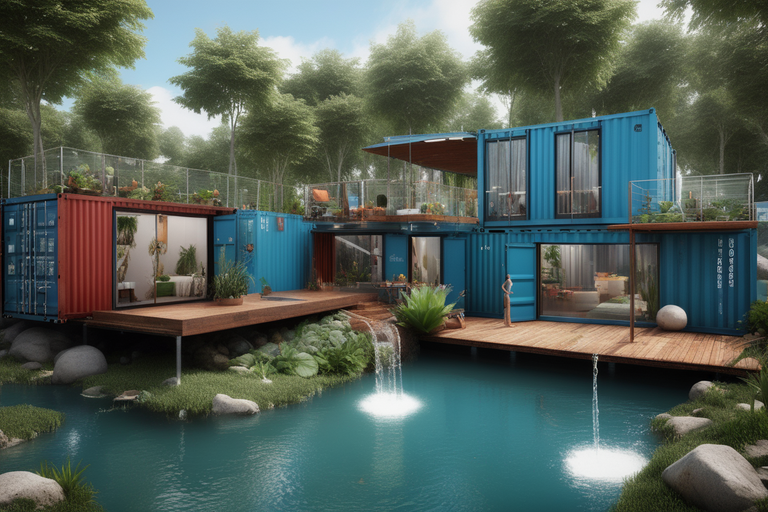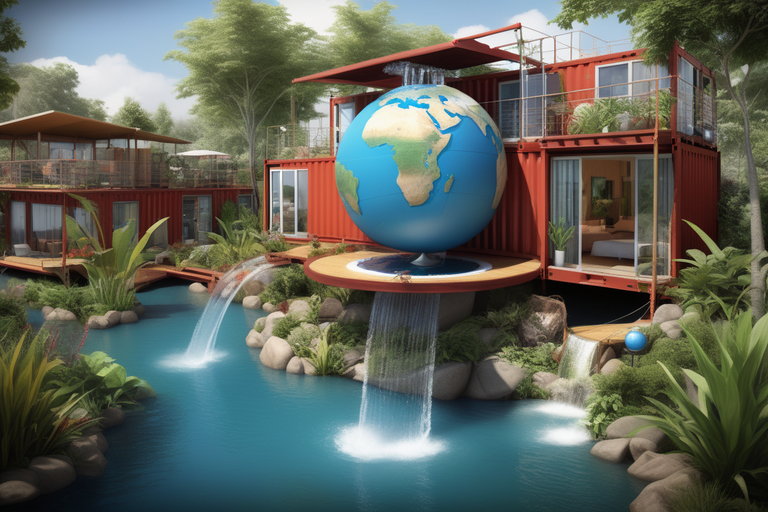In recent years, the concept of tiny homes has gained significant traction as a solution to various housing challenges. These innovative and compact dwellings offer a range of benefits, including affordability, minimal environmental impact, and the ability to create sustainable communities such as eco-villages. One increasingly popular method of constructing tiny homes is through the use of shipping containers. These modular metal structures, originally designed for transporting goods across the globe, have found a new purpose in the realm of sustainable housing. In this article, we will explore the key advantages of shipping container construction for tiny homes, focusing on the keywords “eco” and “eco-village,” while delving into the sections of Affordability, Dependability, Sustainability, and Versatility.
Affordability
One of the most significant advantages of shipping container construction for tiny homes is its affordability. Traditional housing can be prohibitively expensive for many individuals and families, making homeownership an unattainable dream. However, repurposing shipping containers into tiny homes offers an affordable alternative. Containers can be purchased at a fraction of the cost of traditional building materials, significantly reducing the overall construction expenses. Additionally, due to their modular nature, containers allow for easy expansion or adaptation, making it possible to start with a smaller structure and gradually expand as needed. This adaptability provides individuals with the opportunity to build their homes incrementally, without incurring significant upfront costs.
Dependability
Shipping containers are built to withstand the rigors of long-distance transportation, making them incredibly durable and dependable structures for tiny homes. Constructed from sturdy steel, these containers can withstand extreme weather conditions, including hurricanes and earthquakes. Their robust design ensures that they can endure for decades, providing a reliable and secure living space. Moreover, since containers are designed to be stacked, they offer excellent structural integrity, allowing for creative designs and multi-story constructions without compromising safety.
Sustainability
Sustainability is a crucial aspect of eco-village living, and shipping container construction aligns perfectly with this ethos. By repurposing used containers, we reduce waste and minimize the environmental impact associated with traditional construction materials. According to estimates, there are around 17 million shipping containers in the world that are currently not in use. By repurposing even a fraction of these containers into tiny homes, we can significantly reduce the demand for new construction materials, saving energy, resources, and reducing carbon emissions. Additionally, containers can be fitted with various sustainable features such as solar panels, rainwater harvesting systems, and energy-efficient insulation, further enhancing their eco-friendliness.
Versatility
Shipping containers offer unparalleled versatility in tiny home construction. Their modular nature allows for endless design possibilities, enabling homeowners to create unique and personalized living spaces. Containers can be stacked, interconnected, or arranged in various configurations to accommodate different needs and preferences. This flexibility makes them ideal for eco-village communities, where diversity and individuality are valued. Furthermore, containers can be easily transported, allowing individuals to relocate their homes if needed, fostering a sense of mobility and freedom.
Eco-Village Living
The concept of eco-villages aligns perfectly with the principles of shipping container construction. Eco-villages are intentional communities that prioritize sustainability, self-sufficiency, and social cohesion. By utilizing shipping container homes, these communities can promote eco-friendly living while fostering a sense of community and shared responsibility. The affordability of container homes ensures that a diverse range of individuals can participate in these communities, creating a vibrant and inclusive living environment.

Shipping container construction is a popular method for building tiny homes due to the affordability and durability of shipping containers. Shipping containers are made of corten steel, which is a type of steel that is resistant to corrosion and weathering. This makes them ideal for use in the construction of homes, as they can withstand the elements and last for many years.
There are many different ways to build a tiny home with shipping containers. Some people choose to use a single container, while others use multiple containers to create a larger home. Shipping containers can also be stacked on top of each other to create a multi-story home.
The interior of a shipping container home can be customized to fit the needs of the homeowner. Walls can be added to create different rooms, and windows and doors can be installed to provide ventilation and light. Shipping containers can also be insulated to keep them warm in the winter and cool in the summer.
Shipping container construction is a great option for those who are looking for an affordable and sustainable way to build a tiny home. Shipping containers are readily available and relatively inexpensive, and they can be constructed in a short amount of time. Additionally, shipping containers are a durable and environmentally friendly building material.
Here are some of the benefits of building a tiny home with shipping containers
- Affordability: Shipping containers are a relatively inexpensive building material, which can help to save money on the cost of construction.
- Durability: Shipping containers are made of corten steel, which is a type of steel that is resistant to corrosion and weathering. This makes them ideal for use in the construction of homes, as they can withstand the elements and last for many years.
- Sustainability: Shipping containers are a recycled material, which can help to reduce the environmental impact of construction.
- Versatility: Shipping containers can be used to create a variety of different home designs, from small studios to large multi-story homes.
If you are considering building a tiny home with shipping containers, there are a few things to keep in mind
- Shipping containers are not always readily available in all areas. You may need to do some research to find a supplier in your area.
- Shipping containers can be heavy and difficult to transport. You may need to hire a professional to move them for you.
- Shipping containers can be noisy. You may need to add insulation to the walls and ceiling to reduce noise levels.
- Shipping containers can be hot in the summer and cold in the winter. You may need to add insulation and ventilation to keep your home comfortable year-round.
Despite these challenges, building a tiny home with shipping containers can be a rewarding experience. With careful planning and execution, you can create a unique and affordable home that is perfect for your needs.
Final Thoughts
Shipping container construction for tiny homes is an increasingly popular and viable solution for those seeking affordable, dependable, sustainable, and versatile housing options. By repurposing these modular metal structures, we can create eco-friendly communities such as eco-villages, where individuals can live in harmony with nature while minimizing their environmental footprint. The affordability, dependability, sustainability, and versatility of shipping container homes make them an excellent choice for those looking to embrace a simpler, more sustainable way of living.






Shipping container tiny homes are taking the world by storm! These eco-friendly dwellings offer a fun and innovative approach to sustainable living. With their durable steel structure and potential for customization, these compact homes are popping up in eco-villages around the globe. The construction process is not only efficient but also allows for creative design possibilities, making each home truly unique.
Imagine waking up in your own cozy shipping container home within a vibrant eco-village community. It’s like living in a Lego land for adults! People are embracing this trend not just as a housing solution, but as a way of life that promotes minimalism and environmental consciousness. As we continue to see the rise of tiny home communities, it’s evident that the shipping container revolution is here to stay.